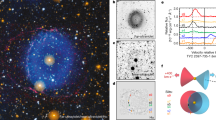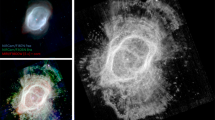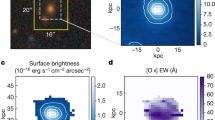Abstract
EVERY friend of astronomical research has learned with great pleasure the news that Prof. Wolf, of Heidelberg, has succeeded in proving by spectrum photography that the well-known ring nebula in Lyra consists of four different gases, which, owing to the rapid rotation of the ring, have been separated and concentrated in four different layers. On using the image of the ring itself instead of the slit of a spectroscope, photographic images of the rings corresponding to the different spectral lines were obtained on the plates, but the dimensions of the rings were found to be different and to correspond to four gases of which the ring nebula is composed. The smallest ring, A, representing the innermost part of the ring, is composed of an unknown gas; the next largest ring, B, is composed of hydrogen; the next largest ring, C, consists of helium; and the largest ring, D, consists of an unknown gas. The question arises, What is the nature of the two unknown gases?
This is a preview of subscription content, access via your institution
Access options
Subscribe to this journal
Receive 51 print issues and online access
$199.00 per year
only $3.90 per issue
Buy this article
- Purchase on Springer Link
- Instant access to full article PDF
Prices may be subject to local taxes which are calculated during checkout
Similar content being viewed by others
Author information
Authors and Affiliations
Rights and permissions
About this article
Cite this article
BRAUNER, B. The Gases of the Ring Nebula in Lyra. Nature 80, 158–159 (1909). https://doi.org/10.1038/080158a0
Issue Date:
DOI: https://doi.org/10.1038/080158a0
Comments
By submitting a comment you agree to abide by our Terms and Community Guidelines. If you find something abusive or that does not comply with our terms or guidelines please flag it as inappropriate.



